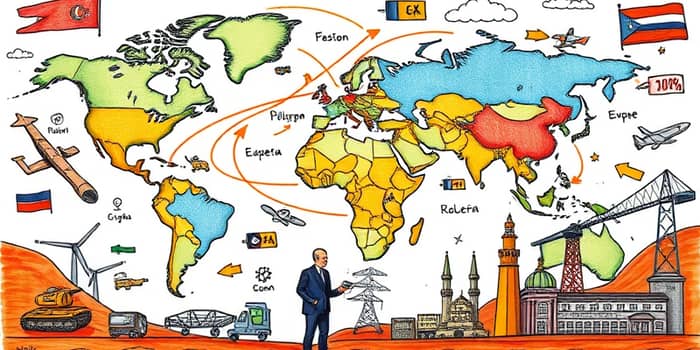
As global tensions reach levels not seen since World War II, investors must contend with an intricate web of conflicts, trade disputes, and shifting alliances. In 2025, geopolitical uncertainty can drive volatility across markets, affecting everything from inflation to supply chains. By understanding these forces, you can position your portfolio to weather storms and seize emerging opportunities.
With 59 active military conflicts worldwide, the rarity and unpredictability of such events make risk pricing a formidable challenge. Yet, prudent analysis and scenario planning offer a path forward.
Several high-profile tensions are reshaping investor sentiment and market dynamics:
Each of these factors introduces economic headwinds and volatility spikes that can lead to rapid asset repricing and liquidity squeezes.
When geopolitical events occur, markets respond swiftly and often harshly. Historical data shows:
Bonds also reflect this turmoil: yields stay elevated due to higher risk premiums, and currencies may shift as economic growth differentials narrow.
Geopolitical shifts do not affect all industries equally. Key sectors stand out:
Regionally, the Asia-Pacific remains a growth engine, buoyed by stimulus in China, while Europe faces trade disputes and tariff uncertainty that temper its outlook.
Investors must balance short-term risks against long-term structural themes. In the near term, markets may face sharp corrections and heightened volatility around headline events. Over a multi-year horizon, secular trends emerge:
Behavioral pitfalls abound. Information overload and misinformation can trap retail investors in panic selling or speculative bubbles.
Central banks navigate a delicate balance: rate cuts in the US and Europe are likely more subdued due to sticky inflation pressures and ongoing uncertainty. Public budgets face strain from elevated defense spending and subsidies, which could raise default risks, particularly in emerging markets.
Global growth forecasts have been revised downward in the EU due to trade tensions but slightly upward thanks to defense-related public investment. Emerging Asia, supported by stimulus measures, remains the fastest-growing region despite headwinds.
Adopt a disciplined approach to manage risk and capture opportunities:
Regularly reassess your portfolio as geopolitical landscapes evolve. Incorporate robust hedges, such as currency strategies and options, to protect against sudden shocks.
In 2025, the interplay of wars, trade conflicts, and shifting alliances creates a complex investment backdrop. While uncertainty may unsettle markets, proactive investors can harness data-driven insights and scenario planning to uncover resilient opportunities. By focusing on structural themes—defense innovation, energy transition, and digital security—while maintaining diversification and quality exposures, you can navigate geopolitical turbulence and position your portfolio for long-term success.
References













